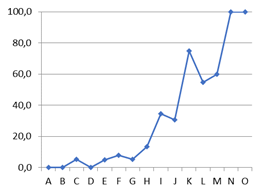PROGNOSIS OF INHALATION INJURY MORTALITY RATE WITH REVISED BAUX SCORE AT DR. SOETOMO GENERAL ACADEMIC HOSPITAL, SURABAYA, INDONESIA (2019-2021)

Downloads
Highlights:
- Fire is the most frequent cause of burns, while thermal contact is the least common.
- Mortality rate with revised Baux score in burn patients with inhalation injury showed a significant relationship.
Abstract:
Introduction: Burn trauma has quite a high mortality rate in Indonesia. One of the scoring systems that is straightforward to apply is the revised Baux score. However, there is no standardised scoring system that is currently in use in our institution. Therefore, the purpose is to determine the feasibility of using this scoring system in our population's features.
Methods: This research is a retrospective study with research design case control design using secondary data in the form of medical record data from patients with acute burn trauma that were admitted to Burn Unit of Dr. Soetomo General Academic Hospital in Surabaya between January 2019 and December 2021. All the data will be divided by their group and analysed with SPSS software.
Results: The study found significant relationships between several factors and mortality rates among burn patients. Age, total burn surface area percentage, presence of inhalation injury, and the revised Baux Score all showed significant correlations with mortality rate (p < 0.005). Specifically, among burn patients with inhalation injury, the correlation between mortality rate and revised Baux score remained significant (p=0.002).
Conclusions:The study revealed that age, the percentage of total burn surface area, and the presence of inhalation injury are significantly associated with mortality rate among burn patients. Additionally, the revised Baux Score was identified as a useful tool for predicting the prognosis of burn patients with inhalation injury. These findings emphasize the importance of these factors in assessing and managing outcomes for burn patients, particularly those with inhalation injury.
World Health Organization. Burns. 2018. (Accessed 8 February 2022). Available from: https://www.who.int/news-room/ fact-sheets/detail/burns)
Wardhana A. Panduan Praktis Manajemen Awal Luka Bakar, 1st ed. Jakarta: Lingkar Studi Bedah Plastik Press; 2014.
Iustitiati M and Nata'admadja BS. A Acomparison of Abbreviated Burn Severity Index (ABSI) Score with R-Baux Score as a Predictor of Mortality in Burn Patients. Jurnal Rekonstruksi dan Estetik. 2022. 7 (2):43–50.
Prawoto AN and Dachlan I, The Use of Amniotic Membrane for Wound Healing in Burn Injuries. Jurnal Rekonstruksi dan Estetik, 2022.7(2): 64–71.
Sjamsuhidajat R dan Jong WD. Luka. In: Sjamsuhidajat R, Jong WD, editors. Buku Ajar Ilmu Bedah, 2nd ed. Jakarta: Penerbit Buku Kedokteran EGC; 2004. p. 81-91.
Herlianita R, Purwanto E, Wahyuningsih I and Pratiwi ID. Clinical outcome and comparison of burn injury scoring systems in burn patient in Indonesia. African Journal of Emergency Medicine. 2021.11(3): 331-334.
Belba MK, Deda LN and Belba GP. Measurements Of Injury-Related Outcomes: Statistical And Analytical Data From Albania. Annals of burns and fire disasters. 2021.34(4): 301-311.
Osler T, Glance LG and Hosmer DW. Simplified estimates of the probability of death after burn injuries: extending and updating the baux score. The Journal of Trauma. 2010,68(3): 690-697
Stephanie B, Michael E, Sam J, Isabel S, Geronimo B, and Sebastian V. 503 The Accuracy of the Revised Baux Score in Predicting Burn Mortality: A Systematic Review. Journal of Burn Care & Research, 2023. 44(Issue Supplement 2):S78.
Christofides C, Moore R, and Nel M. Baux score as a predictor of mortality at the CHBAH adult burns unit. Journal of surgical research,2020.251:53-62.
Hussain A, Choukairi F, and Dunn K. Predicting survival in thermal injury: a systematic review of methodology of composite prediction models. Burns, 2013. 39(5):835-850.
Sheppard NN, Hemington-Gorse S, Shelley OP, Philp B, and Dziewulski P. Prognostic scoring systems in burns: a review. Burns, 2011. 37(8):1288-1295.
Lip HTC, Idris MAMd, Imran FH, Azmah TN, Huei TJ and Thomas M. Predictors of mortality and validation of burn mortality prognostic scores in a Malaysian burns intensive care unit. BMC Emergency Medicine, 2019.68(3): 690-397.
Taylor SL, Lawless M, Curri T, Sen S, Greenhalgh DG and Palmieri TL. Predicting mortality from burns: The need for age-group specific models. Burns, 2014.40(6): 1106-1115.
Hasibuan MIA and Moenadjat Y. Prognostic and Predictive Factors of Mortality in Burn Patients at Dr. Cipto Mangunkusumo General Hospital, Indonesia. The New Ropanasuri Journal of Surgery, 2021.6(2): 11-14.
Tarim MA. Factors affecting mortality in burn patients admitted to intensive care unit. Eastern Journal of Medicine, 2013. 18(2): 72-5.
Fitri A, Saputra D and Putra AE. Perbandingan R-Baux Score dengan BOBI Score sebagai Prediktor Mortalitas Pasien Luka Bakar di RSUP Dr. M. Djamil Padang. Majalah Kedokteran Bandung,2018. 50(2): 79-85.
Wardhana A, Mulyantara I and Kekalih A. Implementation of revised Baux Score to Predict Mortality Burn Injured Patients in Burn Unit of Dr Cipto Mangunkusumo Hospital, Jakarta. The New Ropanasuri Journal of Surgery, 2016. 1(1): 23-26.
Heng JS, Clancy O, Atkins J, Leon-Villapalos J, Williams AJ, Keays R, et al. Revised Baux Score and updated Charlson comorbidity index are independently associated with mortality in burns intensive care patients. Burns, 2015.41(7): 1420-1427.
Jeschke MG, Pinto R, Kraft R, Nathens AB, Finnerty CC, Gamelli RL, et al. Morbidity and Survival Probability in Burn Patients in Modern Burn Care. Critical Care Medicine, 2015. 43(4): 808-815.
Copyright (c) 2024 Dhea Hasna Salsabilla, Agus Santoso Budi, Diah Mira Indramaya, Ronaldo Muslim

This work is licensed under a Creative Commons Attribution-ShareAlike 4.0 International License.
JURNAL REKONSTRUKSI DAN ESTETIK by Unair is licensed under a Creative Commons Attribution-ShareAlike 4.0 International License.
- The journal allows the author to hold copyright of the article without restriction
- The journal allows the author(s) to retain publishing rights without restrictions.
- The legal formal aspect of journal publication accessbility refers to Creative Commons Attribution Share-Alike (CC BY-SA)



















